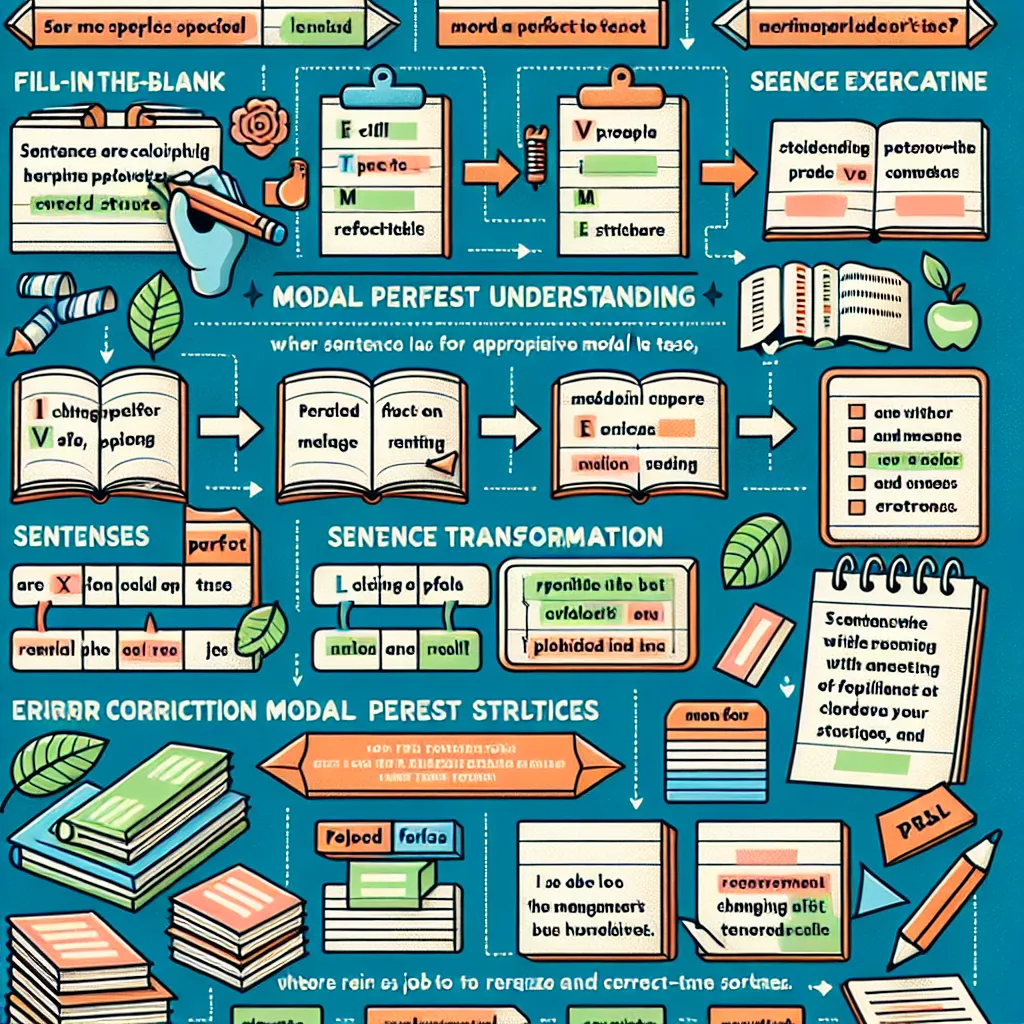Are you struggling with modal perfect in English grammar? You’re not alone. Many English learners find this aspect of grammar challenging, but with the right approach, you can master it. In this guide, we’ll explore effective strategies for Mastering The Use Of Modal Perfect, providing you with clear explanations, practical examples, and valuable tips to enhance your understanding and usage of this important grammatical structure.
Understanding Modal Perfect
Modal perfect combines modal verbs with perfect infinitives to express various meanings about past situations. It’s a crucial aspect of advanced English grammar that allows speakers to convey complex ideas about past possibilities, obligations, or speculations.
What is Modal Perfect?
Modal perfect consists of a modal verb (such as could, should, or would) followed by have and a past participle. For example:
- She could have won the competition.
- They should have arrived by now.
- I would have helped if I had known.
 Modal Perfect Structure
Modal Perfect Structure
Why is Modal Perfect Important?
Mastering modal perfect is essential for several reasons:
- It allows for more nuanced expression of past events and hypothetical situations.
- It’s commonly used in both spoken and written English, especially in academic and professional contexts.
- Understanding modal perfect can significantly improve your overall English proficiency and help you master English grammar in conversation.
Common Modal Perfect Forms and Their Uses
Let’s explore the most frequently used modal perfect forms and their meanings:
Could Have + Past Participle
This form is used to express past ability or possibility that didn’t happen.
Example: “I could have finished the project yesterday, but I decided to take a break instead.”
Should Have + Past Participle
Used to express regret or criticism about past actions.
Example: “You should have called me before coming over.”
Would Have + Past Participle
Typically used in conditional sentences to talk about hypothetical past situations.
Example: “If I had known about the party, I would have attended.”
Must Have + Past Participle
Used to express strong certainty about past events.
Example: “She must have left already; her car isn’t in the parking lot.”
May/Might Have + Past Participle
Expresses possibility or uncertainty about past events.
Example: “He might have missed the train; that’s why he’s late.”
Tips for Mastering Modal Perfect
-
Practice with Context: Always practice modal perfect within full sentences or dialogues to understand its usage in context.
-
Identify the Time Reference: Remember that modal perfect always refers to a past time, even if it’s used in present tense sentences.
-
Understand the Nuances: Each modal verb carries its own nuance. For instance, “could have” implies ability, while “should have” suggests obligation or expectation.
-
Use Real-life Scenarios: Create or imagine scenarios where you might use modal perfect in everyday conversations.
-
Read Extensively: Exposure to authentic materials like novels, newspapers, and academic texts can help you internalize the correct usage of modal perfect.
-
Listen Actively: Pay attention to how native speakers use modal perfect in movies, podcasts, or conversations.
 Modal Perfect Practice Exercise
Modal Perfect Practice Exercise
Common Mistakes to Avoid
-
Incorrect Verb Form: Always use the past participle after “have.” For example, “She could have went” is incorrect; it should be “She could have gone.”
-
Confusing with Simple Past: Remember that modal perfect is used for hypothetical past situations or past speculations, not for definite past events.
-
Overuse: While modal perfect is useful, overusing it can make your speech or writing sound unnatural. Use it only when necessary.
-
Mixing Tenses: Be careful not to mix modal perfect with present or future tenses in the same clause.
Practical Exercises to Improve Your Skills
To truly master the use of modal perfect, regular practice is key. Here are some exercises you can try:
-
Sentence Transformation: Change simple past sentences into modal perfect to express regret or hypothetical situations.
-
Fill in the Blanks: Complete sentences with the appropriate modal perfect form.
-
Error Correction: Identify and correct mistakes in sentences using modal perfect.
-
Writing Practice: Write short paragraphs about past events using modal perfect to express speculation or regret.
-
Speaking Drills: Practice using modal perfect in conversation with a language partner or tutor.
For more practice opportunities, consider practicing English grammar through conversation.
Conclusion
Mastering the use of modal perfect is a significant step in advancing your English language skills. By understanding its structure, practicing regularly, and being mindful of common pitfalls, you can effectively incorporate this grammatical form into your English usage. Remember, like any aspect of language learning, mastery comes with time and consistent practice. Don’t be discouraged by initial difficulties; keep practicing, and you’ll see improvement in your ability to express complex ideas about the past.
For those looking to further enhance their English grammar skills, exploring advanced grammar for business English can be a valuable next step. Keep practicing, stay curious, and watch your English proficiency soar!




